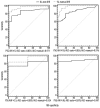Evaluation of the accuracy of manual and automatic scoring of a single airflow channel in patients with a high probability of obstructive sleep apnea
- PMID: 21278698
- PMCID: PMC3524694
- DOI: 10.12659/msm.881379
Evaluation of the accuracy of manual and automatic scoring of a single airflow channel in patients with a high probability of obstructive sleep apnea
Abstract
Background: ApneaLink (AL) is a single-channel type-4 device that measures airflow. A limited number of studies have assessed AL's usefulness in diagnosing obstructive sleep apnea (OSA) using automated scoring alone. This study was conducted to assess the sensitivity and specificity of AL in a selected group of people with clinical suspicion of OSA, using both automatic and manual scoring and comparing the results with those obtained for polysomnography (PSG).
Material/methods: Simultaneous overnight recordings of in-laboratory PSG and AL were performed for 95 patients (mean age 46.3 ± 12.6 yr) with a high clinical suspicion of OSA. PSG was scored manually according to the American Academy of Sleep Medicine (AASM) guidelines. AL data were analyzed automatically using a manufacturer-provided computerized algorithm. Manual scoring of the AL flow signal followed the AASM guidelines for reduction in flow.
Results: The mean apnea hypopneas index (AHI) for PSG was 34.1 ± 32.4/hr. The AL Auto-AHI was 20.1 ± 25.2/h, and the AL Manual-AHI was 39.5 ± 30.4/h. The Pearson correlation coefficients were r=0.883 between PSG-AHI and AL Auto-AHI, and r=0.966 between PSG-AHI and AL Manual-AHI. At AHIs of 5, 10, 15, and 30, the AL Auto sensitivity/specificity was 0.79/0.68, 0.70/0.89, 0.64/0.94 and 0.63/0.98, and the AL Manual sensitivity/specificity was 1.00/0.43, 1.00/0.56, 0.98/0.58 and 1.00/0.80.
Conclusions: Combining auto and manual scoring of data (automatic scoring followed by manual scoring) recorded by single-channel ApneaLink provides good diagnostic agreement with conventional PSG recordings.
Figures



References
-
- Schahin SP, Nechanitzky T, Dittel C, et al. Long-term improvement of insulin sensitivity during CPAP therapy in the obstructive sleep apnoea syndrome. Med Sci Monit. 2008;14(3):CR117–21. - PubMed
-
- Tkacova R, Dorkova Z, Molcanyiova A, et al. Cardiovascular risk and insulin resistance in patients with obstructive sleep apnea. Med Sci Monit. 2008;14(9):CR438–44. - PubMed
-
- Selim B, Won C, Yaggi HK. Cardiovascular consequences of sleep apnea. Clin Chest Med. 2010;31(2):203–20. - PubMed
-
- Bahammam AS, Aljafen B. Sleep medicine service in Saudi Arabia. A quantitative assessment. Saudi Med J. 2007;28(6):917–21. - PubMed
-
- Young T, Evans L, Finn L, Palta M. Estimation of the clinically diagnosed proportion of sleep apnea syndrome in middle-aged men and women. Sleep. 1997;20(9):705–6. - PubMed
Publication types
MeSH terms
LinkOut - more resources
Full Text Sources
Miscellaneous

